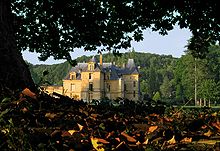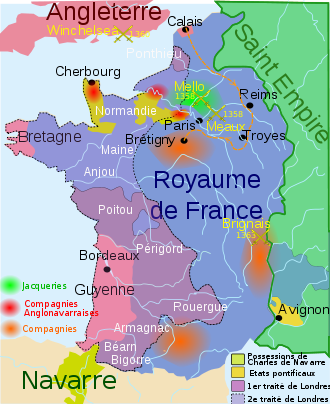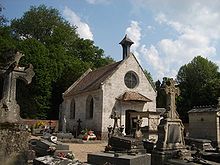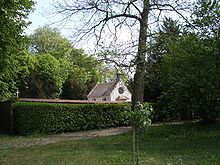- Château d'Acquigny
-
Contents
Between the Rivers Eure and Iton
Acquigny sits at the confluence of two rivers: the Eure, formerly navigable to Chartres, and the Iton. The two rivers were damned and redirected during the twelfth century by the monks of Conches-en-Ouche to power mills in the region. These newly created branches also fed into the castle's moats protecting the Saint-mals monestary and the medieval village located directly behind the current castle.
The gardens surrounding Château d'Acquigny are marked by historic bridges and the Orangerie that date back to the Renaissance and the castle's inception. The high hills along the Eure that once protected vineyards and sheep pastures from the northern winds, today, offer a picturesque backdrop for this landscape, now influenced by the romantic period.
The Castle
Through the end of the Middle ages, the site has been used to monitor travel on the Eure. As such, the original castle played a key role during the franco-normandes wars and later, the franco-english occurring as part of the Hundred Years' War.
Hundred Years' War
Following the imprisonment of Charles II of Navarre in 1356, the Duke of Lancaster was sent by the King of England to rescue Philip of Navarre, brother of Charles. His army of twelve hundred horsemen, sixteen thousand archers and two thousand armed brigandines, convened in Evreux.
The original Castle Acquigny was take by Navarre and his army. Following the Battle of Cocherel, May 16, 1364, the castle served as a refuge and stronghold for Navarre. Control of this strategic location along the two rivers cause much anxiety for the king of France who feared a loss of influence in the High Normandie Region. Charles V instructed his brother Duke of Burgundy to raise an army at Chartres and to divide it into three parts. The first, led by Bertrand du Guesclin went to Cherbourg. The second, led by a favorite of the king Jean Bureau River, went to besiege Acquigny, while the main army attacked Marcerauville. Froissart has said that Jean de la Riviere had in his army over two thousand combatants.[1]
This story emphasizes the strategic importance of the area during the fourteenth century. The original castle was situated in the exact location as the current castle and was surrounded by high walls and wide ditches which flowed in the river Eure.
Castle Acquigny was most likely given to Charles II of Navarre in the Treaty of 6. Article 6 of the treaty states, that the King of France will take over all the castles belonging to the King of Navarre and his brother, except those of Mantes and Meulan.[2] The original castle, however, was razed in 1378 by Charles V who wished to destroy any fortifications and castles in Normandy that stood for the King of Navarre. Charles V was successful in this aim with the exception of Cherbourg, which the French could not capture.[3]
When the British were forced out of Normandy in 1450, Anne de Laval took possession of Acquigny. In an act to pay homage to the king of France, Anne de Laval combined the baronies Acquigny and Crevecoeur Crevecoeur [4] into one, making Acquigny the principle town.
The Castle Today
The present castle was built in 1557 by Anne de Laval, widow of Louis Silly, cousin of the king and first lady of honor Catherine de Medici. She wanted the architects Philibert Delorme and Jacques Androuet Hoop to design a castle inspired by the eternal love she bore for her husband. The castle's seel is made from their four initials intertwined. This influence produced a complex and a unique structure of rare elegance. On the center turret there is a superimposed scallop shell in tribute to the Way of St. James. This facade of honor is coated with many other decorative elements that celebrate the exceptional love she held for her family.
The castle was purchased in 1656 by Claude Roux Cambremont. In 1745, Peter Robert Roux Esneval, known as the President of Acquigny and the great grand son of Claude Roux Cambremont, expanded the castle. Peter Robert Roux Esneval employed architect Charles Thibault to rebuild the chapel of Saint-mals as well as stables and sheds. It was at this time that the orangery was built along with the church and the Little Castle that was designed to be attached to a hermitage.
The Little Castle
The President of Acquigny was a deeply religious man. After rebuilding the church, he chose to live the remainder of his life as a hermit, while strictly adhering to his religious beliefs and the Grande Trappe. From the pavilion end, he could attend services celebrated in the church. The architecture of this construction is simple, and harmonious. The play of colors - Blue slate and pink brick pink set on white stone - and symmetry play an essential role in the beauty and balance of this monument.
Promenade along the water
The vast park created during the 17th century follows a circular route. The forest is filled with large chestnut trees over two hundred years old and drawing comparison stopping at a vegetable garden, the orangery and there are around the vegetable, the general route of the water body perpendicular, but the rows of trees and flower beds are symmetrical disappeared. However, beautiful limes or large chestnuts who have freed themselves from their geometric shape beautify the wood. Two major elements, the garden and orangery, regained some of their former glory. At the beginning of the 19th centure, the network of straight channels has been completed by a sinuous river crossed by a bridge and a romantic path of rocks based on a theme dear to Jean-Jacques Rousseau inReveries of the Solitary Walker. This includes river basins which are reflected the large trees and the Castle, on both sides of waterfalls or the big waterfall. During this walk is the silhouette of the Saint-mals, a tour of the 14th century now protecting the Christ of the former cloister of the Priory or a cottage in the 18th century with iris and Sedum s on the ridge.
References
- ^ Ibid., p. 486. See also Denis-François Shake t. 1, p. 57.
- ^ Shake,Hist. Charles the Bad,p. 85. - Lebrasseur,Hist. County of Evreux,p. 105 proof.
- ^ Shake, P. 199. - Lebrasseur, P. 259.
- ^ This barony, which long remained united with that of Acquigny had been on the river of Eure Near Holy Cross Leufroy
Categories:- Châteaux in France
Wikimedia Foundation. 2010.




